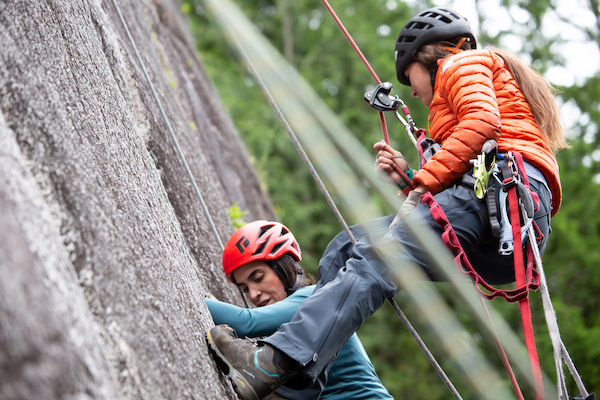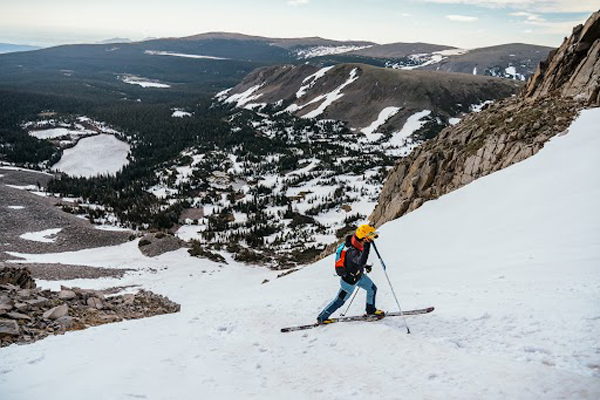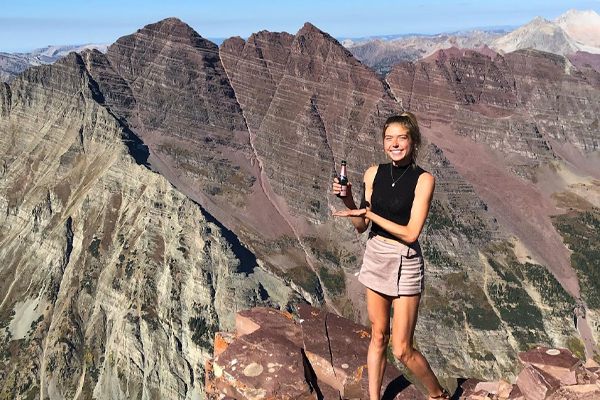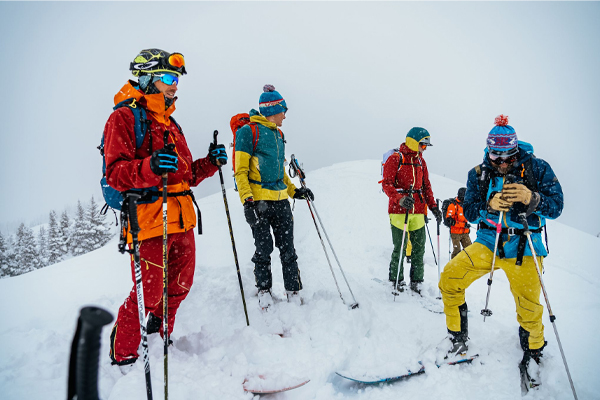Anton Krupicka - Supercanaleta
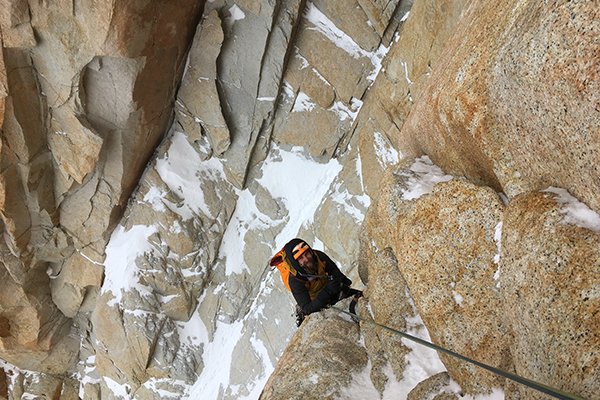
The unforgiving principle of specificity was fully in effect - simply being cardio fit wasn’t enough to move quickly on this terrain...
- - -
When I accepted Colin Haley’s invitation to climb with him in Patagonia for the month of December, I knew it would be a big (okay, enormous) step up. Almost all of my previous climbing experience was in my backyard playgrounds of Colorado—Eldorado Canyon for trad cragging and Rocky Mountain National Park for long alpine rock missions. These are excellent resources that I hold near and dear to my heart, but, of course, they can’t even come close to comparing to the scale, commitment, and complexity of climbing just about anything in the Chalten Massif of Patagonia.
It took a little internal back-and-forth on my part, but ultimately, I figured: 1) there was no better way to gain experience than to learn from the best, 2) Colin invited me so he must’ve seen at least a little potential, 3) Seize the day and all that. For sure, I wouldn’t have felt comfortable skipping so many steps in my climbing progression if my partner wasn’t as experienced and strong as Colin.
As Colin and I prepared dinner at our Piedra Negra bivy site—just below Aguja Guillaumet—on Christmas Eve, I looked up through intermittent squalls of precipitation at the northwestern flank of Guillo and remarked how that random face alone—on the smallest peak in the massif—was like three of Longs Peak’s Diamonds stacked atop one another. Colin responded that only one route had ever been done on that wall (compared to the ~100 on the Diamond!). There are just so many other huge, proud, towering lines, there hasn’t been any need to go searching out the lines between the lines yet. There is a wealth of rock. Crawling into our tent at 6pm—setting a 1:30am alarm—I noted that the last time I’d slept in a tent was nearly 10 years ago (I bought a small-size pick-up with a bed in the back in 2008). Colin guffawed in disbelief before pondering that he’d probably slept 1000 nights in a tent in the last 10 years.
I was the definite noob on this trip. But I knew that going in.
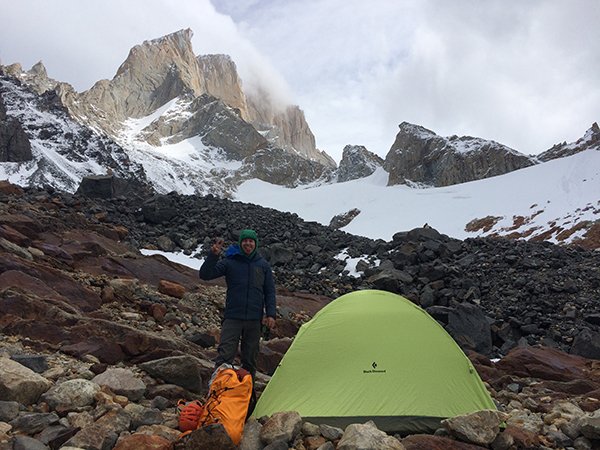
Almost two weeks previous, Colin and I had snagged a town-to-town, warm-up mission on Guillaumet, climbing mostly dry rock on the Comesana-Fonrouge to the summit and then traversing its summit ridge south to the Guillaumet-Mermoz col before rappelling to the west and heading back to town. It was mostly a rock-climbing endeavor, which, in my limited experience, is the medium on which I certainly have the most comfort, so I came away feeling relatively confident and excited for more. The day after that outing, however, the weather behaved badly and stayed that way. It rained a lot in town and dumped in the mountains, ultimately depositing a meter or so of fresh snow at the elevation of Piedra Negra and higher.
One of the loose goals that Colin and I had for our partnership was to try lowering his and Andy Wyatt’s 21 hour car-to-car speed record on Cerro Chalten from last season. The idea was to combine Colin’s alpine experience with my Mountain Running® background. All of this fresh snow, plus each of our continuing illiotibial band injuries, ultimately precluded us from making such an effort, but now with conditions making dry rock nonexistent, we were still interested in trying to summit Chalten via the mega-classic Supercanaleta—a snow, ice, and mixed route on the back (western) side of the mountain.
Even with a speed record attempt out of the question, there was still plenty of uncertainty in the mix: 1) We weren’t sure if our knees would hold up, 2) I had exactly one previous mixed route under my belt—Alexander’s Chimney on Longs Peak back in November, 3) the weather.
Weather: What was once a promising looking weather window over the holiday weekend gradually narrowed to about a 12-18 hour period on Christmas Day where the winds were supposed to abate and the chance for precipitation still existed but dropped considerably. As we hiked up the steep hill to Piedra Negra on Christmas Eve it showered off and on and clouds swirled ominously over the high summits of the massif. Things weren’t looking great.
My experience (or massive lack thereof): Alexander’s is a great route and Longs is maybe my favorite peak anywhere, but, quite simply, it’s a complete joke compared to something like the Supercanaleta. Dean Potter’s ‘schrund-to-summit speed record on the Supercan is still a quite lengthy 6 hours 30 minutes (it took Colin and Andy 7 hours 30 minutes to climb it last year in their car-to-car effort), and it’s a staggering vertical mile of serious terrain. That’s an enormous amount of ground to cover for someone as inexperienced as myself. Again, I simply trusted in Colin’s willingness to head up there with me.
Finally, our knees: We decided to mitigate the strain on our IT bands by jettisoning the car-to-car principle and instead employing the more traditional strategy of breaking the mileage up into a relaxed approach hike to the Piedra Negra bivy camp at the northern end of the range on Saturday and a big push on the route on Sunday.
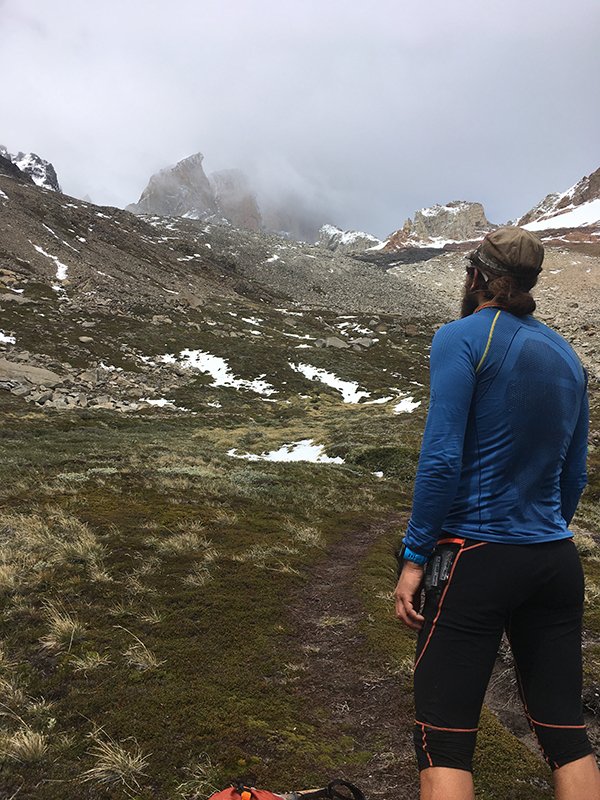
From conversations with other climbers the previous afternoon we knew that there would be at least four parties ahead of us on the route. (A couple teams had bivied on the glacier at the base of the couloir and two others were embarking from Piedra Negra several hours before us.)
We were glad for this for two reasons: 1) nighttime navigation of the heavily-crevassed Glaciar Fitzroy Norte would be much easier following a set of tracks, and 2) a staircase of kicked steps on the initial few hundred feet of vertical in the couloir itself would allow us to climb that much faster. To help keep things interesting for Colin (who had successfully climbed the Supercan three times previously), we were still going to try for a fast ‘schrund-to-summit time, especially since Colin suspected that by taking the never-repeated Directa variation at the top of the mountain, we could cut off a whopping 12-15 pitches of technical mixed climbing from the normal route.
Of course, there were some downsides to this strategy. At 6a A2, the Directa was substantially more difficult than the normal route; I was literally afraid that, in crampons, I wouldn’t even be able to pull the moves on top-rope. Additionally, with so many parties climbing above us, anything they kicked loose in the narrow shaft would rain down on our heads. We rationalized that all the fresh snow would keep most dangerous rubble frozen in place.
When we wriggled into our sleeping bags at 6pm on Christmas Eve, I kinda still couldn’t believe that we were going to be climbing the Supercanaleta in the morning. Even six months ago, the prospect of going for a legitimate attempt at climbing Cerro Chalten would’ve made me laugh at its improbability. Life sometimes takes some surprising turns. Despite my excitement, I actually managed to get a couple hours of sleep and wasn’t even groggy when Tool’s “Stinkfist” (Colin’s alarm) started playing at 1:30am in our tent. Go time.
With an established track to follow in the dark, we left camp at 2:30am and made quick time on the four miles of thankfully now frozen snow and rock over Paso Cuadrado and up the glacier to the base of the route. Despite it being the middle of the night on a glacier, Colin and I both hiked in only our base layers and were still sweating profusely. We took an extended transition at the base to eat, drink, put on helmets, crampons, and harnesses and gather our energies for a strong push. I, for one, was already feeling the effort a bit; we crossed the ‘schrund at 5:05am.
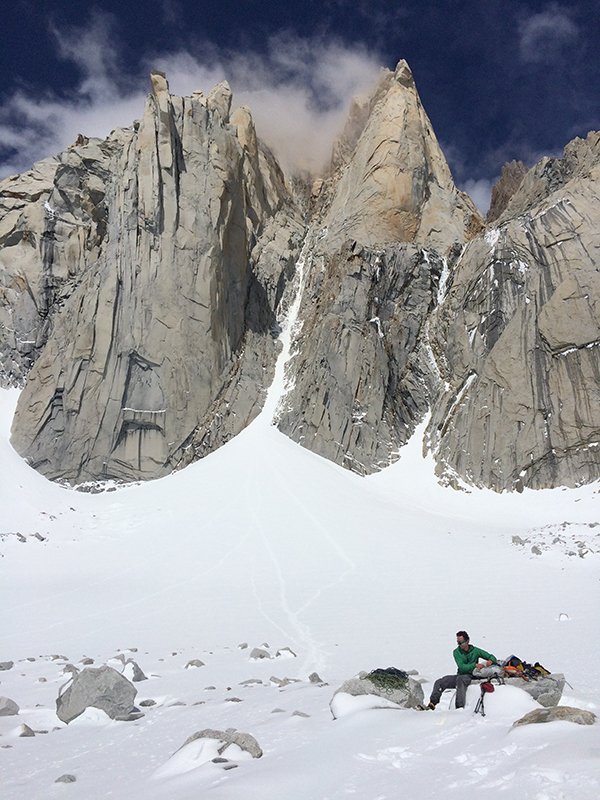
Almost immediately, Colin’s finely-honed efficiency and deep experience on this kind of terrain became apparent. The first couple hundred feet were just kicked steps in steep snow, but this transitioned quickly to interminable front-pointing and daggering on consistent 50-60deg neve and alpine ice. This went on for a full 1000m! Colin said it was the best conditions he’d ever seen on the route. Surprisingly, I never felt gripped, but I obviously didn’t have the same level of comfort as Colin and certainly not the same economy of movement. My calves were pumped almost immediately and I was no doubt over-kicking. A few times it occurred to me that if I messed up it was game over, but those were fleeting thoughts: most of the time I was simply too exhausted trying to keep up with Colin.
This was a surprising thing for me. For sure, what I’ve always considered my strength in the mountains is, quite simply, my strength. When it comes down to cardio, I am generally able to move uphill faster than most. There is no doubt my IT band has compromised my fitness this fall, but earlier in the trip we’d already established that I was still more fit than Colin when it came to hiking uphill. As such, we strategically had me carry more weight in my pack to even things out on approaches, but even with this handicap, keeping up had still never been an issue.
Not so in the Supercanaleta. The unforgiving principle of specificity seemed to be fully in effect. That is, simply being cardio fit wasn’t enough to move quickly on this terrain. Specific training over many years and efficiency with one’s technique were paramount, and no amount of running, biking, skinning, or steep hiking would translate perfectly. As Colin would point out, this is part of why he’s so picky about where he chooses to spend his time (mostly Patagonia, Chamonix and Alaska)—60deg ice and snow slopes are the bread and butter of alpinism and you simply can’t find extended vertical gain on that medium in the Lower 48. You can only become elite at moving quickly on that terrain by practicing it a lot. It was eye-opening, and I certainly gained a new level of respect for the sport.
Despite the parties climbing above us, the amount of debris coming down the route was relatively minimal. There was the odd chunk of ice or shower of snow, but other than a few smaller rocks whistling a bit too close for comfort, nothing was really out of the ordinary. Additionally, the often very narrow width of the couloir prevented any real sense of exposure. There was no question, though—if either of us made a mistake, the result would be a terrifying ride all the way back down to the glacier.
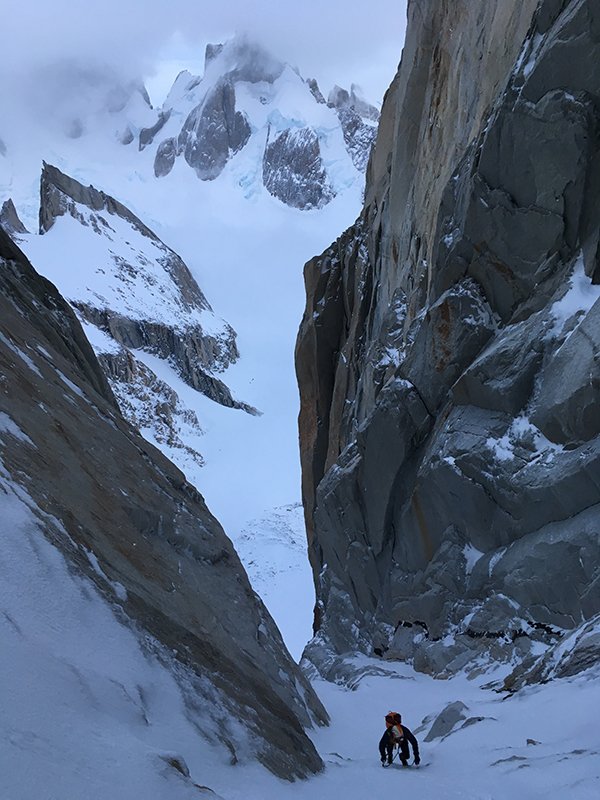
Finally, 1 hour 40 minutes after crossing the bergschrund, we arrived at the “Bloque Empotrado” (“jammed block”), which is where the narrow couloir ends and a few pitches of more technical mixed climbing would take us up to where the Directa deviates from the normal route.
The only problem was that there were two parties queued up on the first pitch with apparently three more in front of them. Oh boy. It was obvious that any chance for trying to go fast was gone, so we took a minute to consider our options and develop a plan. We had planned on simul-climbing this section of the route anyways, and everyone was being friendly, so we eventually just roped up and started climbing through.
The crux was the first pitch, and here I was determined to engage what Colin calls “berserker warrior mode”, just getting up the route by whatever means necessary—pulling on cams, hooking pitons, whatever it takes to not impede Colin’s progress as leader. I tried my best, but, of course, Colin was still mostly climbing faster than me. After the initial mixed crux there were another couple steps of near-vertical waterfall ice that got my attention (second time ever doing this stuff, remember), especially when the debris of snow and ice shards started pouring down from the parties above. I’d been working so hard in the initial 1000m of the route that I still had my shell fully unzipped down to my harness, so of course, all of this flowed directly into my jacket.
And then, adding to the chaotic, frenzied ambiance of the scene, at the bottom of one of these steps I heard a yell from above and shortly after a Petzl Nomic ice tool came tomahawking over the lip! Keep it together people! We would later learn that one of the climbers from a team still above us had taken a leader fall, causing him to drop his tool.
Colin and I simuled this section in two pitches and managed to pass all of the parties in front of us. It was a relief when I reached the first belay on the Directa variation (which continues straight up the gut on much steeper terrain) and the rest of the teams below would eventually split off onto the moderate ramp system of the normal route to the right. It had still only been four hours since the ‘schrund (now a bit after 9am), so despite it feeling much later in the day, my hopes were still very high for reaching the summit in a timely fashion. We were shooting for getting there sometime around noon so that we would have time to rappel all the way back down the route before the afternoon sun started warming the upper slopes of the mountain, which would send ice and rocks down upon us.
The Directa was much more steep and difficult than anything else we’d been climbing all day, so we took a minute here to get out our second half-rope (we’d been simuling on one half-rope) for the next pitch. During this process, we heard some commotion and both looked over just in time to see a body rag-doll down some less-than-vertical, ledgy terrain on the normal route before plummeting over a ~50’ cliff and slam into the snowy couloir below, finally getting caught by his ropes. Good god! This was by far the worst fall I’d ever witnessed in climbing—and very high on the list for Colin—and it had just happened in the alpine high on Cerro Chalten, not at some sunny, roadside crag.
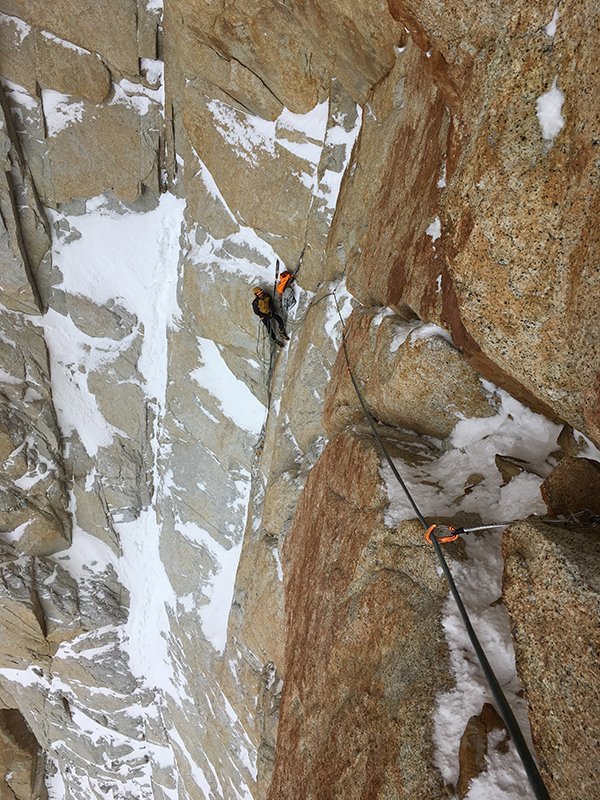
We paused in our preparations, assuming that we would soon be assisting in a long, complicated rescue operation, but after only a few minutes, the climber insisted he was fine and the team reported that they would rappel on their own. Colin yelled down, urging them to wait a few minutes, that the climber was probably in shock, but they soon began rapping. A couple days later, back down in town, we would learn that this was actually the FOURTH fall that climber had taken that morning, including the one where he dropped his ice axe. Sketchy is an understatement.
This whole incident definitely momentarily shook me up a bit. It’s pretty hard to witness something like that and not directly confront just how serious and vulnerable our position on this giant mountain of rock and ice was as tiny little humans composed of comparatively soft flesh and bone. I couldn’t believe how lucky this climber had been.
Nevertheless, Colin soon led away on the first pitch of the Directa, scratching up an insecure, slabby corner before finding some easier terrain and setting a belay at one of the Supercan’s standard rappel anchors. The next pitch straight up looked very difficult—steep rock, a thin, clean corner with ice in the crack. Alternatively, Colin decided to head up a more diagonal line to the right that still looked difficult but perhaps not quite as sheer.
The difficulties began right away, and almost immediately Colin resorted to ad hoc A1 aiding, stepping in a couple Dyneema slings to overcome the steep, iced up terrain and then laboriously lowering and back-cleaning due to the lean nature of our stripped-down alpine rack. It was slow going, and I felt particularly impotent for not possessing the skills nor experience to give Colin a break from the sharp end.
After Colin eventually brought me up this pitch (with a constant and totally necessary assist from the top-rope), I arrived at the anchor to find him chattering with cold. The next pitch looked to be even more consistently steep and rimed with ice. It didn’t take much deliberating to determine that with the forecasted short weather window, our slow progress, and our inadequate rack, the right choice was to go down. There were only a couple of technical pitches remaining to reach Chalten’s moderate summit slopes, but we didn’t relish the thought of having to descend in either that afternoon’s cascading rime nor that evening’s forecasted high winds.
I am convinced that two Colin’s—rather than a Colin and a Tony—would have had the combined fortitude to make it to the summit in a safe manner. That is, if I possessed Colin’s skills and experience, I could’ve offered to take over the lead and give Colin a mental and emotional break from moving the rope up. I still feel a bit sheepish for being so far out of my depth in that moment as to not be able to offer anything but a belay, but this was something we knew when we partnered up, and I’m grateful for Colin still being willing to share a rope with me despite knowing my limitations as a climber. Finally, with the mess of teams queued up on the standard route, making a dash up that was, unfortunately, out of the question.
Fortunately, the rappels went without incident, but the prolonged focus (it took us three hours to rap) needed to get down and out of the chute as quickly and efficiently as possible was a new kind of mental exhaustion for me. After the first couple technical pitches, Colin and I simul-rapped every pitch (at least 25) and many times we had to go off rappel to do short downclimbs to the next set of anchors.
When we were finally back on the glacier—drying our gear in the sun and eating a meager Christmas Dinner of Clif Bars and gels—the day was long from over (the 10 mile hike back out to the road took us until midnight), but we could finally at least let our guard down a little.
In the end, my time in Patagonia has been a fantastic introduction to many of the realities of this spectacular landscape. The Chalten Massif comprises some of the most inspiring, high quality terrain in the world. However, the weather is a huge hurdle. Being mentally prepared for that, it is possible to maintain a positive attitude and remain motivated to get after it once the clouds finally clear. And, if anything, the small taste I’ve had this past month has left me doubly motivated. Motivated to come back, for sure. But also motivated to continue developing my skill level in the meantime, so that in twelve months I’m better equipped to experience this place as a more equal partner.
Photos: Anton Krupicka and Colin Haley
- - -
ABOUT THE AUTHOR
 Anton Krupicka is a member of the La Sportiva Mountain Running® Team.
Anton Krupicka is a member of the La Sportiva Mountain Running® Team.
- - -





